Director's Report
Dr. Emmett Duffy, Director of TMON
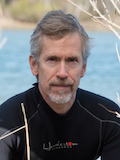
Dear Friends,
Greetings and welcome to the inaugural newsletter of the Tennenbaum Marine Observatories Network and MarineGEO program! The last 18 months have been an exciting maiden voyage as TMON got a crew on board, caught the wind in our sails, and started making headway. This, our first in a regular series of e-newsletters, provides an update on who we are, what we’ve been up to, and what’s on the horizon.
Introducing MarineGEO and TMON
MarineGEO is short for the Marine Global Earth Observatory, an ambitious program establishing a global baseline and accounting of how nearshore marine life is changing, why it's changing, and how that affects the resilience of marine ecosystems. To accomplish this, the Smithsonian is recruiting a global network of collaborators in a coordinated, standardized research program. MarineGEO joins ForestGEO (aka the Center for Tropical Forest Studies), which together comprise the Smithsonian’s signature "Global Earth Observatories" program.
Why do we need this? The ocean provides food, livelihoods, protection, and inspiration to people worldwide. Ocean observing systems have developed rapidly in recent years but, with some notable recent exceptions, they focus mainly on ocean physics and chemistry. Yet biodiversity is the heart of resilient ecosystems. MarineGEO is unique in its explicit focus on biodiversity, on shallow waters where biodiversity and people are concentrated and interact most, its integration of observations and experiments, and in the central role of partnership in our model.
In late 2012, the Smithsonian received a generous pledge of $10M from SI National Board member Michael Tennenbaum and his wife Suzanne to jump-start MarineGEO. This gift allowed the Smithsonian to establish a headquarters for the program, known as the Tennenbaum Marine Observatories Network (TMON), which is centered at the National Museum of Natural History (NMNH) and includes SI marine staff at the Smithsonian Environmental Research Center (SERC), Smithsonian Marine Station at Fort Pierce, Smithsonian Tropical Research Institute, and the Smithsonian Conservation Biology Institute. TMON coordinates and acts as the nerve center of the distributed MarineGEO program. We’re grateful to NMNH Director Kirk Johnson and Invertebrate Zoology Chair Jon Norenburg for welcoming us into their home, to SERC Director Tuck Hines for hosting a TMON research lab in the beautiful new Mathias building—and of course to the MarineGEO Steering Committee, who built the groundwork for all of this over several years.
A growing global network
TMON is a collaboration among all SI units with marine interests, and a growing community of partner institutions. Each TMON node has a lead PI:
SERC, Chesapeake Bay: Matt Ogburn and Whitman Miller;
SMS Fort Pierce, FL: Valerie Paul;
Carrie Bow Cay, Belize: Valerie Paul;
STRI Bocas del Toro, Panama: Andrew Altieri.
The broader MarineGEO initiative is growing quickly, recruiting a diverse array of academic, government, and NGO partners. Partnerships are established or in active development:
San Francisco Bay (Romberg Tiburon Center of San Francisco State University)
Kane'ohe Bay, Hawaii (University of Hawai'i’s Hawai'i Inst. of Marine Biology)
San Juan Islands, Washington (University of Washington’s Friday Harbor Labs)
British Columbia, Canada (Hakai Institute)
Hong Kong (Hong Kong University)
Singapore (Nanyang Technical University)
Several others are still in the ‘silent phase’ of our campaign.
Progress to date
Over the last year or so we have hired a cadre of top-notch staff at HQ and at the field stations, initiated a postdoctoral fellowship program that has brought four outstanding young scientists into the SI marine science community (two arriving fall 2015), advanced MarineGEO partnerships around the world, drafted a document describing our core research program, installed water quality and weather monitoring instrumentation at all four of SI’s current TMON sites, conducted a comparative experiment testing impacts of nutrient pollution and loss of herbivores in seagrass ecosystems, and conducted biodiversity inventory expeditions across the core TMON sites at Fort Pierce, Bocas del Toro, and Carrie Bow Cay. We’ve also launched the MarineGEO website. See below for details.
Thanks for taking the voyage with us, and please keep in touch - we want to hear from you!
With warm regards,
Emmett Duffy
Director, Tennenbaum Marine Observatories Network
MarineGEO Representation At Recent Scientific Meetings
MarineGEO scientists have been busy presenting their work at various conferences around the world, from Canada to China. Below are contributions from different researchers, each representing their own unique perspective within the holistic context of MarineGEO. If you give oral or poster presentations on your MarineGEO work, please share them with us at: MarineGEO@si.edu.
Emmett Duffy gave a plenary talk at the 3rd World Conference on Marine Biodiversity in Qingdao, China:
Title: The United Oceans: A new paradigm for understanding marine biodiversity in a globally connected world
TMON members gave several talks at the Benthic Ecology Meeting in Quebec City this February. Presentation topics included seagrass meadow dynamics, standardized predation assays, and the importance of biodiversity.
Oral Presentations
Authors: Campbell, J.; Johnston, L.; Paul, V.; Kuempel, C.; Altieri, A.; Duffy, E.
Title: Responses of tropical seagrass meadows (Thalassia testudinum) to experimental manipulations of nutrient supply and consumer abundance
Authors: Paul, V.; Campbell, J.; Gunasekera, S.
Title: Nutrient enrichment increases the abundance of toxic cyanobacteria in a tropical seagrass bed
Author: Duffy, E.
Title: Biodiversity is as important as physics
Authors: Ziegler, S. L.; Bippus, P. M.; Duffy, J. E.
Title: BiteMap: A simple, scalable assay to quantify predation pressure along environmental gradients
MarineGEO Research Highlights
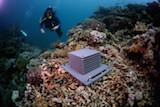 Marine biodiversity: Seeing beyond the tip of the iceberg. Matt Leray and Nancy Knowlton of NMNH recently published molecular analyses from biodiversity collections at MarineGEO sites in Florida and Virginia, showing that even at these relatively well-studied sites, there were >1000 species each, and over a third of the smaller organisms (sequenced via meta-barcoding) could not even be assigned to a known taxonomic group, much less a described species. The research employed Autonomous Reef Monitoring Structures (ARMS)—standardized “condos” for marine animals—and was featured in an article in The Washington Post.
Marine biodiversity: Seeing beyond the tip of the iceberg. Matt Leray and Nancy Knowlton of NMNH recently published molecular analyses from biodiversity collections at MarineGEO sites in Florida and Virginia, showing that even at these relatively well-studied sites, there were >1000 species each, and over a third of the smaller organisms (sequenced via meta-barcoding) could not even be assigned to a known taxonomic group, much less a described species. The research employed Autonomous Reef Monitoring Structures (ARMS)—standardized “condos” for marine animals—and was featured in an article in The Washington Post.
Chris Meyer, Nancy, and others recently established an ARMS Center at NMNH to coordinate the growing global network of ARMS sites, and MarineGEO has adopted ARMS as part of the toolbox that we will deploy worldwide to characterize biodiversity in a standardized way. For details on how they work and where they’re already deployed, see the ARMS webpage hosted by NOAA.
Taking an iconic national park underwater. For more than 30 years, the intrepid field biologist Dan Janzen (Pennsylvania University) has been working with local partners to build and restore tropical dry forest in the Area Conservacion de Guanacaste on the Pacific coast of Costa Rica. The park is among conservation’s shining success stories. It has always had a marine sector but the biodiversity beneath the waves has never been surveyed. In January 2015, Emmett Duffy, Jonathan Coddington, and Katie Barker traveled to the area to meet with Dan and a host of Costa Rican scientists, conservationists, and government officials to discuss partnership toward a marine inventory of the area. As a first step in that direction a team led by Chris Meyer and Laetitia Plaisance of NMNH will deploy ARMS in the region in July 2015. MarineGEO is working with partners there, led by Prof. Jorge Cortes of the Universidad de Costa Rica, toward development of a collaborative research program in hopes that the area will join us as a MarineGEO node.
Health care for tropical seagrass meadows. Seagrasses provide important habitats and ecosystem services in shallow waters from polar seas to the tropics along margins of every continent except Antarctica. But they are threatened by both nutrient pollution and food webs altered by fishing. With grant support from the Smithsonian Grand Challenges Consortia, TMON launched a coordinated experiment testing the relative impacts of these stressors on turtlegrass (Thalassia testudinum) meadows in Panama, Belize, the Indian River lagoon, and Florida Keys. Led by Justin Campbell, Andrew Altieri, and Valerie Paul, the experiments revealed that the same stressor can have quite different impacts on seagrass ecosystems in different regions, likely depending on the dominance of fish versus invertebrate herbivores and on local nutrient levels. The results highlight the key importance of the local biological community in predicting how coastal systems respond to nutrient loading. The team is recruiting colleagues throughout the Caribbean region to expand this research and link it with the similar ZEN network (www.zenscience.org) covering temperate eelgrass habitats.
MarineGEO Goes To Hollywood!
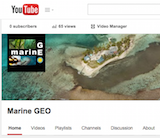 Well, not literally. But we have ventured into the video genre. To advance MarineGEO's mission of educating and engaging people at all levels, we’ve started a YouTube channel to communicate our science. With the help of Cyndi Wood at Creative Project Management we’ve so far posted three videos highlighting remote fish sensing techniques, the 'squidpop' assay we are using to build a global map of fish feeding activity, and the importance of seagrass meadows. The team will be working with colleagues throughout the MarineGEO network to create up to ten more videos over the coming year with support from a Smithsonian Women's Committee Grant.
Well, not literally. But we have ventured into the video genre. To advance MarineGEO's mission of educating and engaging people at all levels, we’ve started a YouTube channel to communicate our science. With the help of Cyndi Wood at Creative Project Management we’ve so far posted three videos highlighting remote fish sensing techniques, the 'squidpop' assay we are using to build a global map of fish feeding activity, and the importance of seagrass meadows. The team will be working with colleagues throughout the MarineGEO network to create up to ten more videos over the coming year with support from a Smithsonian Women's Committee Grant.
MarineGEO Social Media Is Up And Running
MarineGEO is connected! We are active on several social media platforms including Facebook, Twitter, and Flickr. We encourage you to follow and "like" these feeds for the latest news from MarineGEO and to raise our profile. If you're active on social media and want to link your posts to your MarineGEO work, use the #TMON and #SImarineGEO hashtags. If you have newsworthy items or are interested in contributing to one or more of our social media feeds, please contact MarineGEO for details.
The new and improved MarineGEO/TMON website debuted in October 2014 with the launch of SI’s public campaign. There you can find the latest news and happenings from around the network. We are happy to receive feedback on the functionality or appearance of the website - which remains a work in progress - so please let us know.
Special Thanks To Maggie Toscano
Maria & Ross Join MarineGEO Headquarters
MarineGEO is delighted to welcome two new staff members to the Tennenbaum Marine Observatories Network, both of whom started officially on January 12th, 2015. Please join us in welcoming these new members of the TMON team!
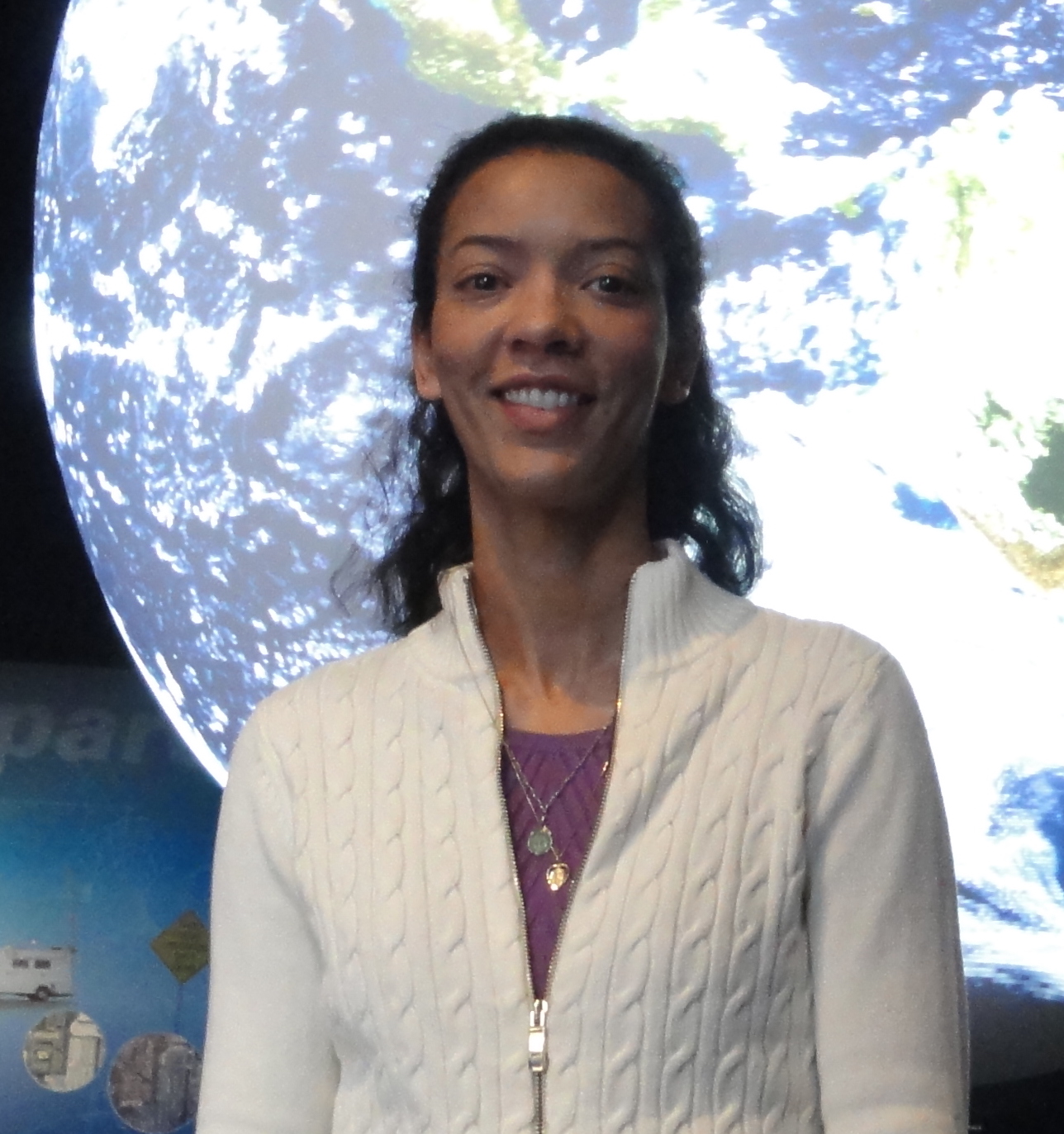 Dr. Maria Murray joined the Smithsonian Institution in January as the Program Manager for MarineGEO and the Tennenbaum Marine Observatories Network. She is based at the National Museum of Natural History and comes with strong experience in collaborative project and partnership management. Before arriving at SI, Maria worked as the Informal Science Education Program Coordinator for five years in the Office of Education at the National Oceanic and Atmospheric Administration. Among other educational partnerships, she coordinated NOAA’s Science On a Sphere Users Collaborative Network, a collaborative network of over 100 international institutions working to increase the effectiveness of a unique global data visualization system as a tool for communicating Earth system science. SI’s National Museum of Natural History is a member of this network. In 2012, Maria received her Ph.D. in Biology from the University of Maryland—College Park, where she studied local adaptation in the eastern oyster hybrid zone through selection patterns in population genomics. Maria also held a 2010 Knauss Marine Policy Fellowship placement in the NOAA Office of Education.
Dr. Maria Murray joined the Smithsonian Institution in January as the Program Manager for MarineGEO and the Tennenbaum Marine Observatories Network. She is based at the National Museum of Natural History and comes with strong experience in collaborative project and partnership management. Before arriving at SI, Maria worked as the Informal Science Education Program Coordinator for five years in the Office of Education at the National Oceanic and Atmospheric Administration. Among other educational partnerships, she coordinated NOAA’s Science On a Sphere Users Collaborative Network, a collaborative network of over 100 international institutions working to increase the effectiveness of a unique global data visualization system as a tool for communicating Earth system science. SI’s National Museum of Natural History is a member of this network. In 2012, Maria received her Ph.D. in Biology from the University of Maryland—College Park, where she studied local adaptation in the eastern oyster hybrid zone through selection patterns in population genomics. Maria also held a 2010 Knauss Marine Policy Fellowship placement in the NOAA Office of Education.
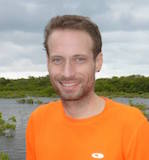 Ross Whippo joins us as the central Biological Research Technician for TMON. Ross received his MSc in Zoology from the University of British Columbia in 2013, studying seagrass epifaunal communities of Barkley Sound, BC. Ross has extensive experience as a research technician on marine biodiversity projects in rocky shores, kelp forests, seagrass meadows (including ZEN British Columbia), and mudflats at marine labs in the US and Canada, including Friday Harbor Laboratories, Bamfield Marine Sciences Centre, and the Hakai Institute. He is also an experienced scientific diver, having served as assistant instructor for FHL’s scientific diving course, and currently serves on the American Academy of Underwater Sciences (AAUS) Membership Committee. Ross is located at the Smithsonian Environmental Research Center.
Ross Whippo joins us as the central Biological Research Technician for TMON. Ross received his MSc in Zoology from the University of British Columbia in 2013, studying seagrass epifaunal communities of Barkley Sound, BC. Ross has extensive experience as a research technician on marine biodiversity projects in rocky shores, kelp forests, seagrass meadows (including ZEN British Columbia), and mudflats at marine labs in the US and Canada, including Friday Harbor Laboratories, Bamfield Marine Sciences Centre, and the Hakai Institute. He is also an experienced scientific diver, having served as assistant instructor for FHL’s scientific diving course, and currently serves on the American Academy of Underwater Sciences (AAUS) Membership Committee. Ross is located at the Smithsonian Environmental Research Center.
New MarineGEO Post-docs Simon Brandl & Erica Staaterman
MarineGEO is excited to welcome two new post-docs to our ranks. Erica Staaterman and Simon Brandl will be joining the MarineGEO family in the coming months and will be bringing with them a wide range of expertise that will complement TMON's own research efforts in the coming years.
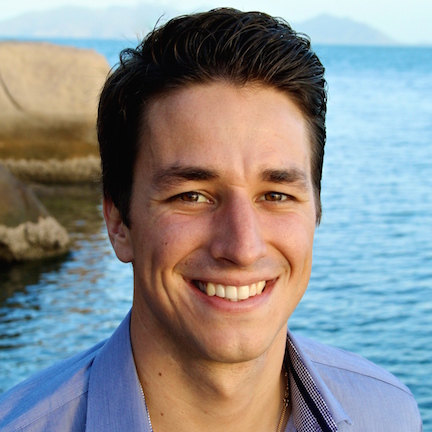 Simon Brandl has always been intrigued by the effects that animals have on their environment. After eagerly watching squirrels, birds, and the occasional freshwater fish during his childhood in Munich, Germany, he set out in order to investigate one of the most diverse systems worldwide, the Great Barrier Reef in Australia. Having completed his PhD at James Cook University in Townsville, he is now looking forward to the challenge of understanding the role of marine biodiversity in a different part of the world.
Simon Brandl has always been intrigued by the effects that animals have on their environment. After eagerly watching squirrels, birds, and the occasional freshwater fish during his childhood in Munich, Germany, he set out in order to investigate one of the most diverse systems worldwide, the Great Barrier Reef in Australia. Having completed his PhD at James Cook University in Townsville, he is now looking forward to the challenge of understanding the role of marine biodiversity in a different part of the world.
As a MarineGEO postdoctoral fellow, Simon will conduct the first large-scale examination of the diversity-stability relationship in marine systems and test how biodiversity patterns and their responses to human influence affect ecosystems along our coasts. He will perform a year-long experiment during which he will assess the stability of seagrass beds and communities on wooden dock-pilings from Maine to Panama, simultaneously simulating human impact by denying consumer species such as fish, crabs, or large animals like turtles and sharks access to the experimental plots. In doing so, he aims to understand how human activities such as fishing affect entire ecosystems, whether this effect differs between the tropics and the temperate zone, and if we can prevent the future destabilization of natural habitats by strategically protecting marine biodiversity.
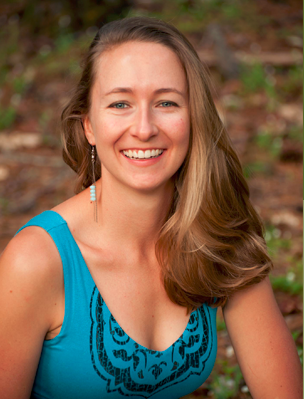 Erica Staaterman explores auditory scenes in the ocean: the clicks, chirps, and growls of a world that was once thought to be silent. As an acoustic ecologist, she has studied communication in mantis shrimp, lobsters, and most recently, baby fish. Erica is also the director of Beneath the Waves Film Festival, which brings the stories of marine scientists and conservationists to global audiences through film festivals and innovative public outreach events.
Erica Staaterman explores auditory scenes in the ocean: the clicks, chirps, and growls of a world that was once thought to be silent. As an acoustic ecologist, she has studied communication in mantis shrimp, lobsters, and most recently, baby fish. Erica is also the director of Beneath the Waves Film Festival, which brings the stories of marine scientists and conservationists to global audiences through film festivals and innovative public outreach events.
Erica proposes to add an acoustic dimension to the planned MarineGEO surveys in temperate (SERC) and tropical areas (STRI). Several acoustic recorders will be deployed simultaneously to the MarineGEO surveys, and will be moved around to survey different habitats within each region. In addition, one stationary recorder will be deployed at each site for an entire year to examine changes across seasons and lunar cycles. This sampling design will allow her to resolve spatial and temporal patterns in marine soundscapes, and their relationships to biological community composition. This project can later be scaled-up to cover broader spatial and temporal scales, thus providing a basis of comparison for present-day to future conditions. As humans rapidly change the marine environment, and in turn degrade marine soundscapes, it is important to conduct this research before it is too late.
New MarineGEO Technicians Janina Seemann & Dean Janiak
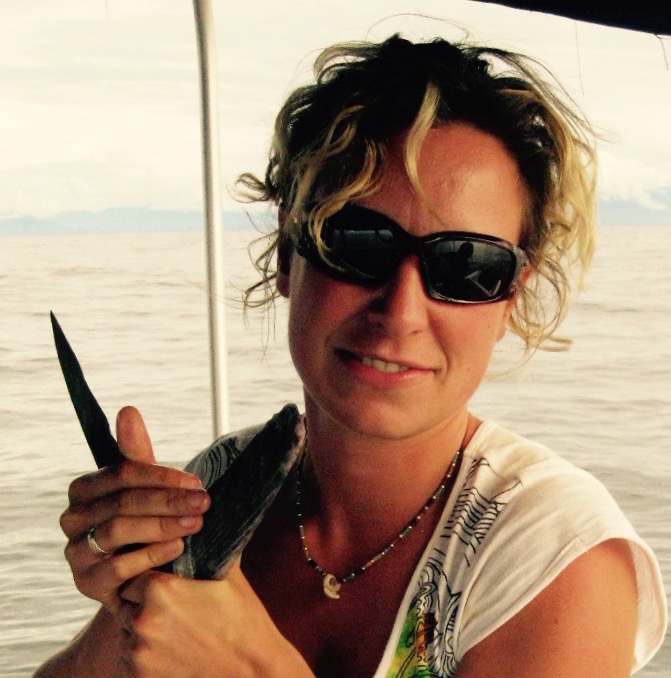 Janina Seemann is a Marine Biologist working for MarineGEO at the Smithsonian Tropical Research Institute in Bocas del Toro, Panama. She spent the past year working as a post-doc researcher conducting feeding experiments and isotope and lipid studies to investigate adaptation processes of coral symbiosis in feeding and photosynthesis. In addition, she conducted reef monitoring and biodiversity studies to compare how human impact levels affect reefs ecosystems.
Janina Seemann is a Marine Biologist working for MarineGEO at the Smithsonian Tropical Research Institute in Bocas del Toro, Panama. She spent the past year working as a post-doc researcher conducting feeding experiments and isotope and lipid studies to investigate adaptation processes of coral symbiosis in feeding and photosynthesis. In addition, she conducted reef monitoring and biodiversity studies to compare how human impact levels affect reefs ecosystems.
Now, she will be coordinating the MarineGEO monitoring initiatives in Bocas del Toro, which include site monitoring for mangroves, seagrasses, and coral reefs during field campaigns. Her hope is to bring MarineGEO ideals to her own work, as well as to the public to foster an attitude of improving their protection and sustainable use.
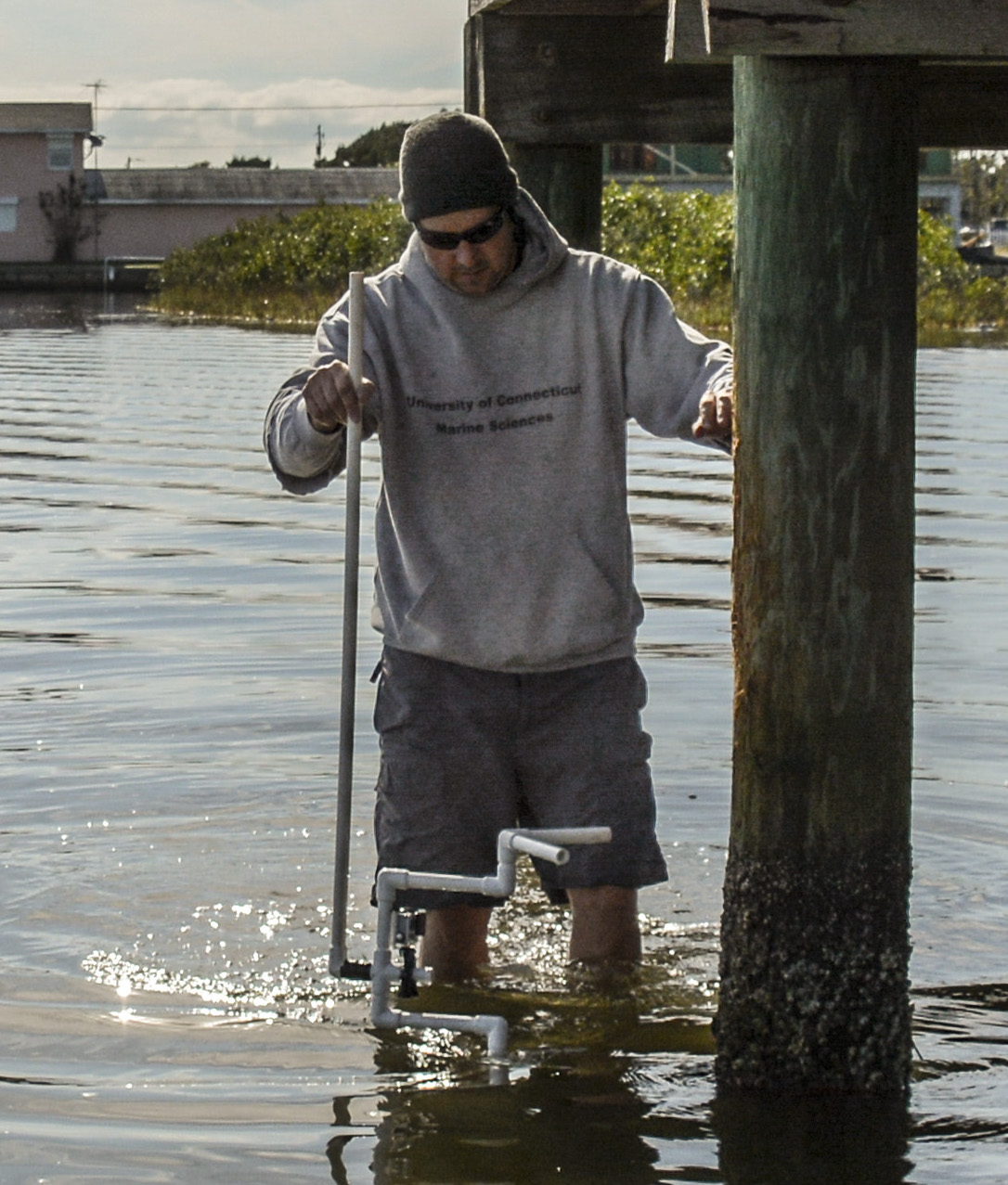 Dean Janiak has been with the Smithsonian for seven years and has recently moved to the Smithsonian Marine Station (SMS) in Florida to work with MarineGEO. Previously, he worked in the Benthic Ecology Lab at the Smithsonian Environmental Research Center (SERC), though being in the not-so-salty Chesapeake Bay was difficult for him as most of his interests lie in the ecology and biodiversity of marine invertebrates.
Dean Janiak has been with the Smithsonian for seven years and has recently moved to the Smithsonian Marine Station (SMS) in Florida to work with MarineGEO. Previously, he worked in the Benthic Ecology Lab at the Smithsonian Environmental Research Center (SERC), though being in the not-so-salty Chesapeake Bay was difficult for him as most of his interests lie in the ecology and biodiversity of marine invertebrates.
Two components of MarineGEO that he has focused on are infaunal and epifaunal communities. At SERC, he recently completed a biodiversity study to identify all animals present in soft sediments and to detect whether the abundances of these organisms changed due to habitat type (mud, sand, etc.). He also examined artificial structures (riprap, bulkhead) to see what effects humans have on these species. Besides working in the mud, Dean also works on all those animals that make a living above the mud (epifauna) on rocks, seagrasses, mangroves, and docks - and in fact he is leading the expansion of MarineGEO monitoring into human-built environments (see the feature on Dean’s work in the Trópicos article) He is particularly interested in how predators as well as invasive species shape communities and how this varies around the world.
MarineGEO Post-docs Are Getting Things Done
MarineGEO post-docs Brian Cheng and Lisa Schile have been busy this past year collecting data on invasive species and carbon storage respectively. Here is a brief update on their progress:
Brian is asking if non-native species have a more difficult time invading the tropics versus the temperate zone. Recently, he began his experiments in seagrass habitat at Bocas del Toro, Panama (STRI) as well as in Fort Pierce, Florida (SMS). In these experiments, the tropics appear to be a tough place to invade! In Panama, less than 10% of invaders survived. Survival at Fort Pierce was approximately 50%. In June, Brian will setup an additional site at Carrie Bow Cay, Belize.
Lisa has conducted field work in Belize, Panama, and San Francisco Bay taking deep soil cores in mangroves, salt marshes, and seagrass beds to measure carbon sequestration. So far, she has collected 40 mangrove and marsh cores and 11 seagrass cores. Currently, she is in the middle of processing all of the soil. She also initiated a decomposition experiment using tea bags, which is part of a large scale international projection looking at plant decomposition rates in wetlands.
Belize & Panama
Lisa Schile & Scott Beers wrangle their corer.
Photo: R. Whippo
Bocas del Toro expedition 2015. In March 2015 a team of over 20 Smithsonian scientists and colleagues converged on STRI’s Bocas del Toro field station for a multifaceted MarineGEO research blitz. We surveyed a large number of reef, seagrass, and mangrove sites, tested new protocols, and initiated experiments. The team was joined by science journalist Sean Mattson of the Smithsonian Tropical Research Institute, who produced an beautiful, illustrated article about the expedition and program in STRI’s online magazine Trópicos.
We are grateful to TMON staff biologist Dr. Janina Seemann (STRI) and Program Manager Dr. Maria Murray, who led the planning, organization, and facilitation of the expedition, and to all participants for their continuous and dedicated work to make the campaign a success.
Latest Publications
Leray M, Knowlton N. 2015. DNA barcoding and metabarcoding of standardized samples reveal patterns of marine benthic diversity. PNAS. 112:7. 2076-2081.
Pagenkopp Lohan K, Hill-Spanik KM, Torchin ME, Strong EE, Fleischer RC, Ruiz GM. 2015. Molecular phylogentics reveals first record and invasion of Saccostrea species in the Caribbean. Marine Biology. doi: 10.1007/s00227-015-2637-5
Successful Grants For MarineGEO Scientists
MarineGEO scientists and collaborators have been busy building the capital to accomplish the innovative and exciting projects that will carry our network into the future. Here are our most recent grant recipients and the projects they are working on:
PI: TMON
Title: Engaging broad audiences in critical coastal science
Award: Smithsonian Women's Committee Grant
Amount: $16,668
Description: The Smithsonian Women’s Committee is a volunteer grant-making organization dedicated to advancing the Smithsonian mission to increase and diffuse knowledge. The TMON team is thankful for a generous grant from the Smithsonian Women’s Committee that will support building the multimedia infrastructure within TMON as both a scientific tool to accomplish research objectives and a way of communicating Smithsonian science to the public. The funds will be used to produce ten videos over the course of the coming year that will be posted to the website, and also to support a citizen science pilot. In addition to educating the public about our marine research, this project will encourage and incentivize a growing contingent of scientific and citizen partners, from the Smithsonian and around the world, to contribute and participate in this emerging global network.
PI: Valerie Paul, Andrew Altieri, Justin Campbell, Emmett Duffy
Title: An experimental network for understanding seagrass (Thalassia testudinum) biodiversity and ecology - Advancing the Tennenbaum Marine Observatories Network
Award: Smithsonian Grand Challenges Award
Amount: $100,000
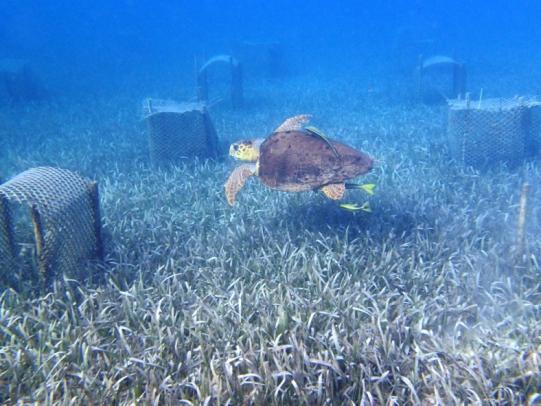
Macrograzers present at an experimental array in Belize
Photo: J. Campbell
PI: C. Sea McKeon, Christopher Meyer, Emmett Duffy, Valerie Paul, Ilka "Candy" Feller, Carole Baldwin, Mark Torchin
Title: Carrie Bow Biocode: Connecting TMON and GGI through the first Atlantic Biocode
Award: Smithsonian Grand Challenges Award
Amount: $17,888
Description: The Smithsonian Institution has a long history of biological investigation in the Caribbean, with the Caribbean Coral Reef Ecosystem Program (CCRE) and the Carrie Bow Cay field station (CBC) serving as key nodes for Smithsonian collections, ecological research, and understanding of tropical marine ecosystems. This history, paired with modern molecular methodologies allows for an unprecedented opportunity to accelerate our understanding of these critical near-shore ecosystems while connecting two signature programs: Global Earth Observatories and BioGenomics. This grant will allow a team to sequence the entire marine biota of CBC creating the first Atlantic biocode. Covering one of the best studied marine sites in the Caribbean region, this curated collection of sequences and images will provide a library for comparison to other TMON sites and provide an opportunity for genetic studies of ecological connectivity through the targeted gut sequencing and other metagenomic samples. The Level 1 proposal will fund a pilot study to evaluate methodology and information systems, a trans-institutional workshop at SERC for engaged parties, and an internship series to curate and help analyze digital assets.
PI: Rachel Collin, Jon Norenburg, Mark Torchin, Valerie Paul, Gregory Ruiz
Title: Carrie Bow Biocode: Connecting TMON and GGI through the first Atlantic Biocode
Award: Smithsonian Grand Challenges Award
Amount: $19,200
Description: Documenting marine biodiversity, its geographic patterns, environmental correlates, and its response to human impacts are some of the major goals of SI's MarineGEO. An important first step in this ambitious agenda is to bring together diverse data sources to understand what we do and do not know about the biodiversity at each of the TMON sites. For three of the sites a wealth of data on species diversity is available from online taxonomic databases, DNA barcode databases, as well as museum collections and researchers' unpublished observations. This project will focus on those Greater Caribbean TMON sites (Bocas del Toro, Panama, Carrie Bow Cay, Belize and Fort Pierce, FL) to understand how these different sources can be reconciled to highlight what we already know about the regional biodiversity encompassed by the 3 sites, and where significant gaps could be filled with targeted future sampling. The PIs will work closely together to guide a research assistant/technician to mine existing information to understand how much of the diversity has been captured by museum samples, DNA sequences, photo-‐ vouchers, and taxonomic identifications. The resulting database will be used to analyze the relationships of the faunas at these sites and, on a phylum by phylum basis, the relationships with the fauna of the rest of the Caribbean. Finally the database will provide a useful indicator of the numbers and percentage of invasive species at each site. This project is part of the Marine Global Earth Observatories in the consortium for Understanding and Sustaining a Biodiverse Planet.
Progress For MarineGEO Partnerships
MarineGEO’s ambition from the beginning has been to understand the dynamics of nearshore marine ecosystems at the grandest scale—poles to tropics and from prehistoric times into the future. To best capture the major environmental gradients, we're focusing our initial efforts on building out along the two coasts of the Americas. We are establishing a beachhead in the Pacific via signed agreements with San Francisco State University and the University of Hawaii, and agreements under development with the University of Washington’s Friday Harbor Labs, the Hakai Institute in British Columbia, and Stanford University’s Hopkins Marine Station. Of course no marine program worth its salt (sorry …) can ignore the biodiversity hotspot of the Indo-Pacific, so we recently signed an agreement with Nanyang Technical University of Singapore and are in discussions with Hong Kong University and the University of Tasmania in Australia, among others.
Stay tuned!

